B&M Siro-Drift
| B&M Siro-Drift | |
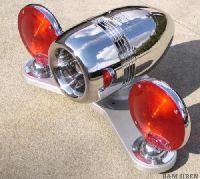 A B&M Super Chief, mounted to a Coast Spot Light 'Wing Platter'. Photo courtesy of B&M. | |
| Company | Bayless & Miles Siren Manufacturing Co. |
|---|---|
| Produced | 1913-present |
| Type | Friction Directional |
The Siro-Drift is a series of friction and electromechanical vehicular sirens produced by B&M Siren Manufacturing Company, which includes a wide variety of sirens, including the flagship Super-Chief. Like many of B&M's sirens, these sirens are known for their ear-piercing pitch and deafening volume and are stiff competition to other popular mechanical vehicular sirens like the Q-Siren and various electronic sirens. The mechanical B&M sirens lived through 10 generations, and three models are still in production today.
History
The Bayless & Miles Siren Manufacturing Company was formed in the early 1910s by James Bayless and Lester Miles, who sought to create friction sirens for motorcycles. Bayless would leave the company in 1921 after losing interest in sirens, signing over the rights to the company to Miles. B&M enjoyed widespread success over the following decades, with their vehicular Siro-Drift sirens outperforming competing sirens such as Sterling's vehicular sirens and Federal's Q-Siren. Unfortunately, in the 1980s many municipalities chose to switch to using electronic sirens instead of mechanical sirens to reduce the load on vehicular electric systems, which caused most customers to stop buying B&M's sirens. As a result, B&M became largely forgotten over the following decades with many believing B&M had gone out of business. In the 2000s, mechanical sirens saw a resurgence in popularity, but the 20 years that had passed caused most to forget B&M existed as those who knew of B&M began to retire. Because of that, most stations instead went with inferior options that had better marketing. The company was inherited by B&M employee Kevin O'Connell in 1998, who ran the company until his untimely death from pancreatic cancer in 2019. Another employee named Brian currently runs the company.
Despite the aforementioned challenges, B&M still exists today and still offers sirens that outperform every other mechanical vehicular siren on the market, as well as restoring older sirens. All of B&M's sirens are hand-built in the United States, using almost exclusively American-built parts instead of outsourcing them to China and other countries. As a result, B&M's sirens offer superior longevity and performance compared to other cheaply-built sirens. B&M currently relies on word-of-mouth to get their name out there, so it is recommended to bring up the company when fire departments are looking for new sirens.
A HUGE thanks to Bryce from B&M for supplying most of this information that was previously unknown.
Models
Friction Sirens
B&M produced friction driven sirens from 1913 all the way to the early 1980s. Friction sirens require no electricity to operate, instead, the siren is on a pivoting base and has a friction roller on the back of the siren which makes contact with a motorcycle wheel, engine flywheel, or crankshaft extension. This makes the siren ramp up, and the speed and size of the object driving the siren determines how loud the siren gets. B&M friction sirens were discontinued in the 1980s, as they were considered obsolete and unsafe for use. There are multiple known incidents of police motorcyclists getting injured from exploding friction sirens. B&M produced these three friction sirens:
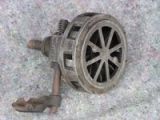
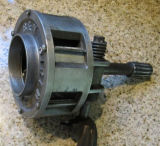
Model MC
The Model MC is a simple motorcycle siren, and was B&M's first siren, introduced in 1913 and built until the late 1930s. Being B&M's first siren, it was not the most effective. The 1st gen. MC has a 6-inch stator with a wide "spider-arm" intake and an 8-port rotor with straight, bi-directional vanes. The 1st gen. MC got a slight refresh during production, seeing an improved tighter air intake. In the late 1930s, the MC was completely redesigned, now with a 5-inch 6-port stator and a rotor with curved vanes, meaning the siren operates much more efficiently at a smaller size. The second generation MC could also be equipped with a 90 degree horn, creating smoother airflow and slightly improved forwards projection. It could be mounted above the front wheel or in front of the rear wheel on either side. The 2nd gen. MC was a popular choice for Moto Guzzi motorcycles, but was ultimately discontinued later down the line due to the safety hazards of friction sirens.
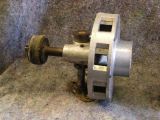
Model 8F
The Model 8F was an automotive friction siren, introduced in the 1910s and produced until the late 1930s. The 8F has an 8-inch, 8-port stator and a rotor with straight long vanes, though a couple examples with short vanes have been discovered. The 8F had a friction roller made of compressed cotton, being driven by an engine flywheel or extended crankshaft, often on fire engines. One 8F with the large projector off a B&M CS8 siren is known to exist. It is the largest friction siren that B&M produced.
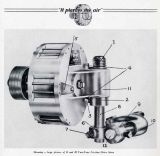
Model 6FA
The Model 6FA was an automotive friction siren, introduced in the 1920s and produced into the 1950s. The 6FA has a 6-inch, 6-port stator and a curved vane rotor inside, presumably the same rotor out of the 6GA electric siren. Like the 8F, the 6FA had a friction roller made of compressed cotton, and could be driven by an engine flywheel, extended crankshaft, custom engine fan, or generator pulley. The 6FA was most commonly seen used in police cars and ambulances. It could have been ordered with either a regular intake or a custom horn. The 6FA was discontinued in the 1950s, as automotive friction sirens were becoming obsolete in favor of regular motor driven sirens.
Electric Sirens
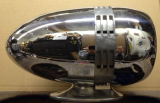
Super Chief
The Super Chief was designed in the 1950s as a response to Federal's Q-Siren, and utilized a space-age streamlined design to deliver superior performance. Like most of B&M's other vehicular sirens, the Super Chief uses an 8-port rotor and stator with curved rotor vanes, driven by a 12 V DC electric motor at a high speed. The Super Chief was designed with maximum efficiency in mind, so the company opted to use Lockheed Martin's Long Beach wind tunnels (used to test aircraft aerodynamics) to find the most efficient design. It was found that a smooth, cone-shaped intake was the most efficient way of making the siren's sound carry, and the siren was designed around it. B&M had experimented with streamlining their S8B for appearance purposes, but the Super Chief was the first siren to be streamlined specifically for performance. The Super Chief combines this smooth, cone-shaped intake with curved rotor vanes to produce a significant amount of sound even at low RPMs. The motor is housed inside a bullet-shaped chromed housing, and the siren sits on a small stand.
Some of these sirens were designed specially for use in Crown's fire engines, with a special bowl-shaped projector placed around the siren to project the sound forwards. These sirens were meant to be placed behind a special round grille just below the cab. These would ultimately cease production after it was found that placing sirens behind a vehicle's grille resulted in too much noise penetrating the cab.
Even 70 years after it first began production, the Super Chief is still currently the loudest mechanical vehicular siren on the market.
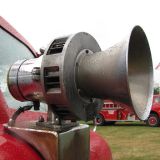
Model CS8B
Although not much is known about these, they have a general design of a basic fire engine siren with a horn projector attached to the front of the siren. Hardly any models are known to exist.
Model S8B
WIP
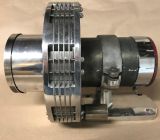
Model S10B
The S-10B is a special-order siren that was produced in very limited numbers. Essentially B&M's 10GA outdoor warning siren flipped on its side, the siren uses an 8-port, 10-inch rotor driven by a 12 V DC electric motor. Minor modifications had to be made to fit the DC motor to the siren. The 10GA's motor (which is borrowed from the Super Chief) was not meant for a siren of this size, and as a result struggles to reach full speed. B&M considered making a larger motor to fit this siren, but decided otherwise as B&M specializes in low-amp motors and such a large motor would draw too many amps. In addition, the Super Chief outperforms the S-10B while having a much lower amp draw. Only a handful of these sirens were produced, all of which were for collectors and was never meant for commercial use.
Electronic Sirens
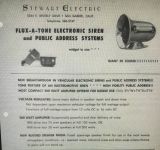
Flux-A-Tone
The Flux-A-Tone was a short-lived 50-75 W electronic siren that was created in a side venture between B&M and another company known as Stewart Electric around 1968. This siren was very short-lived, Walter R. Stewart (who owned and ran the company) fell ill and Stewart Electric ceased operations shortly afterwards. The siren was advertised as "Midget in size, GIANT IN SOUND!!!!!!!!!!" and ran on a 200 W amplifier that could support up to two 75 W sirens or four 50 W sirens. The siren was able to run on 12-16 V DC, and boasted both high performance and clear, high-fidelity voice capabilities. The siren has a very basic space-age design for an electronic vehicular siren, which looks similar to many contemporary sirens of the era. It came standard in a chrome finish. It is unknown if any units survive today.